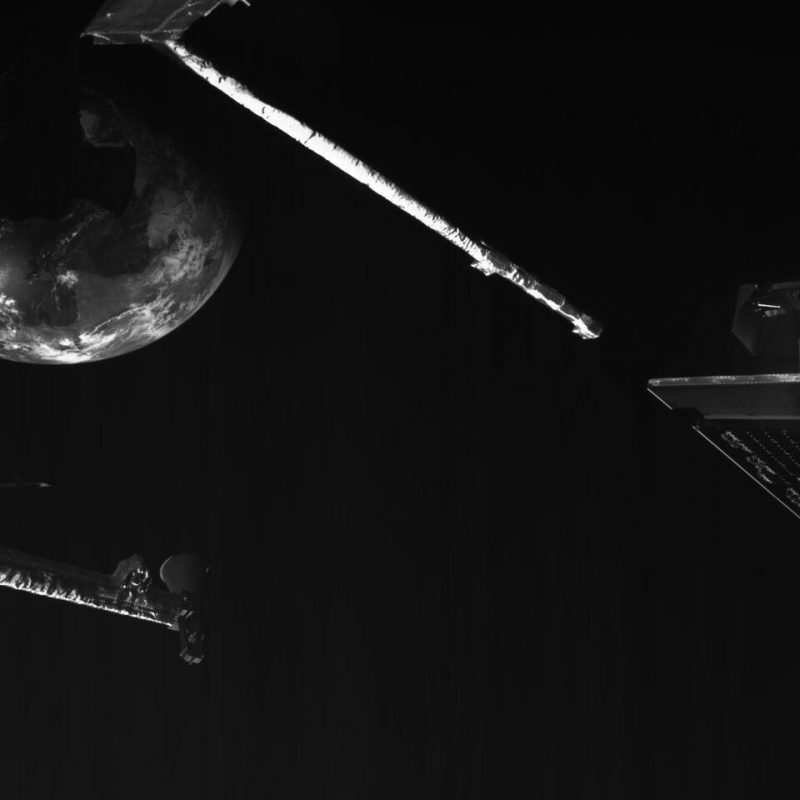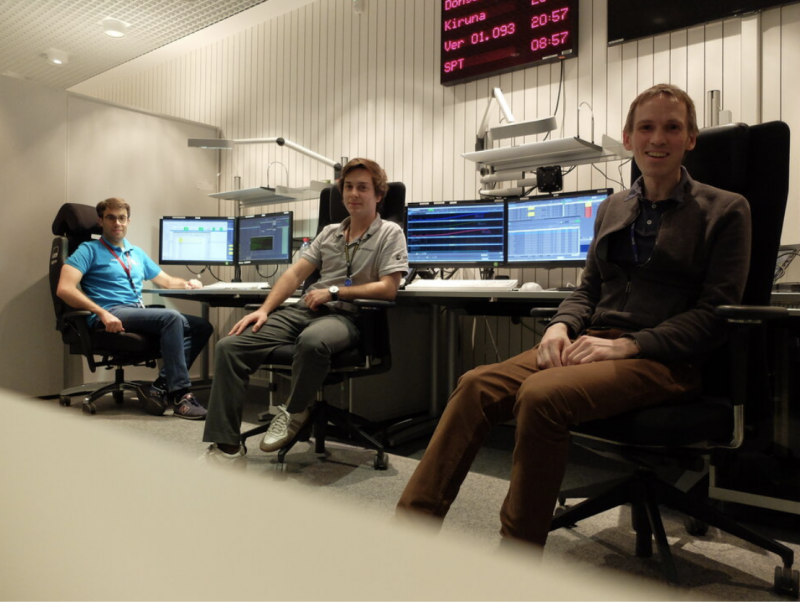

The European-Japanese Mercury mission BepiColombo used one of its M-CAM selfie cameras to capture this glimpse of Earth, as the spacecraft hurtled past the planet during its first and only Earth flyby last night. The image was taken from a distance of around 11,500 miles (18, 600 km) at 03:35 UTC on April 10, 2020, shortly before its closest Earth-approach. Image via ESA.
The European Space Agency (ESA) announced during the night last night (April 10, 2020) that the BepiColombo spacecraft had successfully completed the first of nine planetary flybys – in this case of our own planet, Earth – coming less than 8,000 miles (12,700 km) from Earth’s surface at 04:25 UTC (12:25 a.m. EDT). Translate UTC to your time. The tug of Earth’s gravity finely altered the spacecraft’s speed and direction, steering it subtly toward its final destination, Mercury. ESA said:
Images gathered just before closest approach portray our planet shining through darkness, during one of humankind’s most challenging times in recent history.
ESA said the flybys:
… together with the onboard solar propulsion system, will help the spacecraft reach its target orbit around Mercury. The next two flybys will take place at Venus and a further six at Mercury itself.
ESA said the flyby didn’t require any active operations from the BepiColombo ground team, such as firing thrusters. But it did include 34 critical minutes shortly after BepiColombo’s closest approach to our planet, when the spacecraft flew through Earth’s shadow. Elsa Montagnon, BepiColombo Spacecraft Operations Manager for ESA, explained why the team needed to be on hand at ESA’s mission control center in Darmstadt, Germany, for this maneuver:
This eclipse phase was the most delicate part of the flyby, with the spacecraft passing through the shadow of our planet and not receiving any direct sunlight for the first time after launch.
It is always nerve-wracking to know a spacecraft’s solar panels are not bathed in sunlight. When we saw the solar cells had restarted to generate electrical current, we knew BepiColombo was finally out of Earth’s shadow and ready to proceed on its interplanetary journey.
As BepiColombo swung by our planet, most scientific instruments on ESA’s Mercury Planetary Orbiter – one of the two science spacecraft that make up the mission – were switched on. Several sensors were also active on the second component of the mission, including JAXA’s Mercury Magnetospheric Orbiter, also known as Mio.
Launched in 2018, BepiColombo is on a seven-year journey to Mercury, the smallest and innermost planet orbiting the sun. Read more: Top 5 Mercury mysteries that BepiColombo will solve.

The BepiColombo flight control team – observing safe social distancing at ESA’s mission control center in Darmstadt, Germany – celebrated BepiColombo’s flyby with a selfie of their own. The flyby had been programmed long in advance and was impossible to postpone. It had to be prepared with limited on-site personnel. Image via ESA.
Bottom line: The BepiColombo spacecraft – en route to Mercury – successfully used Earth’s gravity last night to fine-tune its journey to the innermost part of the solar system. During the close flyby, BepiColombo captured images of Earth.
from EarthSky https://ift.tt/2Xp0Pru


The European-Japanese Mercury mission BepiColombo used one of its M-CAM selfie cameras to capture this glimpse of Earth, as the spacecraft hurtled past the planet during its first and only Earth flyby last night. The image was taken from a distance of around 11,500 miles (18, 600 km) at 03:35 UTC on April 10, 2020, shortly before its closest Earth-approach. Image via ESA.
The European Space Agency (ESA) announced during the night last night (April 10, 2020) that the BepiColombo spacecraft had successfully completed the first of nine planetary flybys – in this case of our own planet, Earth – coming less than 8,000 miles (12,700 km) from Earth’s surface at 04:25 UTC (12:25 a.m. EDT). Translate UTC to your time. The tug of Earth’s gravity finely altered the spacecraft’s speed and direction, steering it subtly toward its final destination, Mercury. ESA said:
Images gathered just before closest approach portray our planet shining through darkness, during one of humankind’s most challenging times in recent history.
ESA said the flybys:
… together with the onboard solar propulsion system, will help the spacecraft reach its target orbit around Mercury. The next two flybys will take place at Venus and a further six at Mercury itself.
ESA said the flyby didn’t require any active operations from the BepiColombo ground team, such as firing thrusters. But it did include 34 critical minutes shortly after BepiColombo’s closest approach to our planet, when the spacecraft flew through Earth’s shadow. Elsa Montagnon, BepiColombo Spacecraft Operations Manager for ESA, explained why the team needed to be on hand at ESA’s mission control center in Darmstadt, Germany, for this maneuver:
This eclipse phase was the most delicate part of the flyby, with the spacecraft passing through the shadow of our planet and not receiving any direct sunlight for the first time after launch.
It is always nerve-wracking to know a spacecraft’s solar panels are not bathed in sunlight. When we saw the solar cells had restarted to generate electrical current, we knew BepiColombo was finally out of Earth’s shadow and ready to proceed on its interplanetary journey.
As BepiColombo swung by our planet, most scientific instruments on ESA’s Mercury Planetary Orbiter – one of the two science spacecraft that make up the mission – were switched on. Several sensors were also active on the second component of the mission, including JAXA’s Mercury Magnetospheric Orbiter, also known as Mio.
Launched in 2018, BepiColombo is on a seven-year journey to Mercury, the smallest and innermost planet orbiting the sun. Read more: Top 5 Mercury mysteries that BepiColombo will solve.

The BepiColombo flight control team – observing safe social distancing at ESA’s mission control center in Darmstadt, Germany – celebrated BepiColombo’s flyby with a selfie of their own. The flyby had been programmed long in advance and was impossible to postpone. It had to be prepared with limited on-site personnel. Image via ESA.
Bottom line: The BepiColombo spacecraft – en route to Mercury – successfully used Earth’s gravity last night to fine-tune its journey to the innermost part of the solar system. During the close flyby, BepiColombo captured images of Earth.
from EarthSky https://ift.tt/2Xp0Pru

Aucun commentaire:
Enregistrer un commentaire